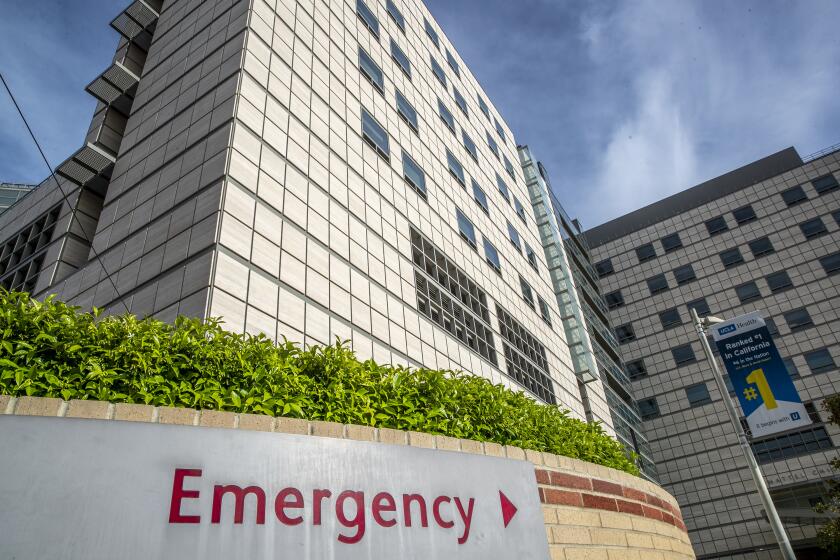Year of Tiger Gets a Noisy Start at Chinatown Parade
- Share via
The serpentine body of a Chinese dragon, symbolizing good fortune, gyrated through the streets of Chinatown Saturday as members of Southern California’s diverse Chinese community gathered for the climax of celebrations welcoming the Year of the Tiger.
“The dragon is supposed to be a heavenly animal,” said Richard Van, master of the Yau Kung Mon Kung Fu Institute in Los Angeles, which provided the 150-foot-long golden dragon and some of the lion dancers. “On the New Year, if you see a heavenly animal--the dragon--that brings good luck, prosperity, health and peace.”
As firecrackers split the air, a crowd of about 20,000 lined the parade route, applauding the passage of dignitaries, including astronaut Taylor Wang, the first Chinese-American in space, who served as grand marshal. About 1,000 marchers participated.
No other event matches the annual parade’s capacity to bring together ethnic Chinese from throughout the Los Angeles area, cutting across divisions between immigrants and American-born Chinese, between speakers of Mandarin and Cantonese, and between those who may sympathize with one side or the other in the continuing rivalry between the Communist government in Peking and the Nationalist government in Taipei. Everyone loves a good dragon dance.
“This is a celebration for all Chinese--no matter what their background is, no matter what their politics are, no matter what their province is,” said Anthony Tse, chairman of Saturday’s Golden Dragon Parade, which also featured floats, bands, drill teams and lion dancers. A total of 81 organizations, non-Chinese as well as Chinese, participated.
“They are carrying on their traditions, they’re passing them down and the younger people are constantly treading in their footsteps,” commented Virgil Terpack, a Riverside-based professional float maker who has been associated with the parade for more than a dozen years.
“It’s good for the community,” Terpack said. “I see solidarity there. You get the butcher, the baker, the candlestick maker--the banker. They’re all working together.”
Tse said that conflicting views toward the rival governments of mainland China and Taiwan often lead to sharp divisions among ethnic Chinese in the United States, and that because of this no national flags other than the American flag are permitted in the parade.
Founded by immigrants from China’s southern Guangzhou Province, Chinatown is largely a Cantonese-speaking community. This character has been preserved through the influx of large numbers of Cantonese-speaking ethnic Chinese refugees from Vietnam in recent years.
Chinese residents of Monterey Park and adjacent cities are much more likely to be Mandarin-speaking immigrants from Taiwan, while Chinese-Americans born in the United States may not speak Chinese at all.
Bob Gin of Monterey Park, a teacher at the Yau Kung Mon Kung Fu Institute, noted that people from throughout the Southland join the Chinatown events.
“Our queen is from Orange County,” Gin said. “There’s a big Chinese group in the San Gabriel Valley, and they come and participate. . . . I really do believe the parade helps to bring everybody together.”
Judy Wang, of Los Alamitos, who reigned over the festivities as Miss Chinatown 1986, was chosen from among 13 beauty pageant finalists. Seven of the 13 were born in the United States, two in Hong Kong, two in Taiwan, one in Korea and one in Vietnam.
Sponsored by the Chinese Chamber of Commerce, the parade is also Chinatown’s biggest draw of the year for non-Chinese visitors. Saturday’s event--marking the year 4684 by the Chinese lunar calendar--was held under cloudy skies after a morning downpour prompted fears among organizers that they might have to cancel it for the first time in its two-decade history.
For many of the roughly 200,000 ethnic Chinese in the Los Angeles area, the New Year’s season began more than a week ago, in a rush to fulfill financial obligations and finish traditional spring housecleaning before New Year’s Day, last Sunday.
Traditionally, debts should be settled to provide a fresh start for the new year, without creditors. In modern American life, paying off all debts before the new year generally is not practical, said Tse, who also is manager of the Chinatown branch of Bank of America.
“They don’t pay off their loans, but they make their payments on time,” Tse said. “Always, around Chinese New Year, our delinquency ratio on loans goes way down.”
New Year’s Day combines the gift-giving of Christmas--in the form of red envelopes for money presented by elders to the younger generations--with the family togetherness and feasting of Thanksgiving.
Gin, 35, said that four generations of his family--about 20 people in all--gathered at his parents’ home last Sunday to dine on shark’s fin soup, steamed chicken, roast duck and other traditional dishes.
As for the red envelopes of lucky money, Gin said: “In my family, my parents are giving it to me, my grandparents are giving it to me, and they give it to my kids. And I give it to my kids and to my nieces and nephews.”
In keeping with the sense of the new year as a fresh start, “you have new clothes, you get a haircut. . . ,” Tse said. “You greet people by saying ‘Gung Hay Fat Choy’ (which literally means ‘Congratulations and Be Prosperous’). . . . It’s a time when you try to reconcile differences.”
The Chinese zodiac represents a 12-year cycle, with each year represented by a specific animal. It is said that people tend to have the personality characteristics of the animal that represents the year of their birth.
One version of how animal names were assigned to the cycle of years relates that when the Buddha lay on his deathbed, he summoned all the animals of the world to appear before him. Only 12 came, and each was honored by having a year named for him. First came the rat, which was followed by the ox, tiger, hare, dragon, snake, horse, ram, monkey, rooster, dog and boar.
People born in the Year of the Tiger are said to have warm personalities and a sensitive nature, with tendencies to be short-tempered and stubborn.
The New Year celebration continues today with a community carnival from noon to 10 p.m. along North Hill Street at College Street. Traditional and contemporary dances, martial arts demonstrations and musical performances are also scheduled from noon to dusk at Central Plaza and Mandarin Plaza.
More to Read
Sign up for Essential California
The most important California stories and recommendations in your inbox every morning.
You may occasionally receive promotional content from the Los Angeles Times.













